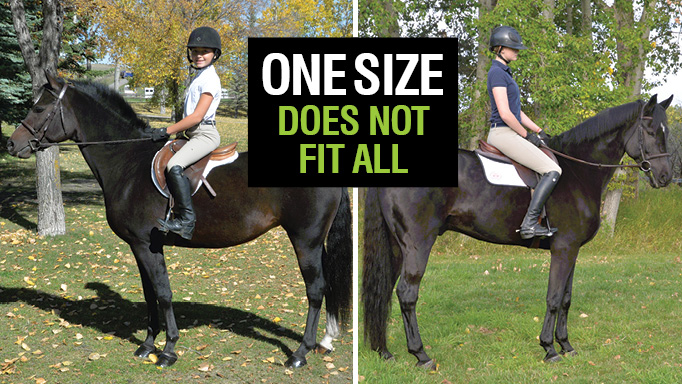When looking to purchase a horse for myself or a customer, size suitability plays a huge factor in determining the ideal match. As a trainer, it is important to match the conformation of the horse and conformation of the rider to create a pair that work well together. We want the rider to be safe, effective, balanced, and not working against their mount.
In the earliest stages of development for the rider, it is important to realize that learning how to ride is hard enough, and mount the riders accordingly so that they are given a positive introduction. Especially with kids, having the right size and fit can make a huge difference in how they learn to ride and whether or not it is a safe and enjoyable experience for them.
Mounting a rider is a bit like putting together a puzzle: you have to identify the aspects of the rider’s conformation that will need to be matched with the horse, and then find a horse that possesses the conformation that will enhance and not hinder the rider’s conformation. For example, if the rider has short arms, a horse with a long neck will make it difficult for the rider to find balance in their upper body, as they will be pulled forward. Instead, find a horse with a slightly shorter neck that is built uphill. A rider with a short leg will have a difficult time getting their leg around a horse with a big barrel; instead, find a slightly slab-sided (narrow-barrelled) horse so the rider can get their leg down and around
Too Heavy for Your Horse?
A British research study into horse-to-rider weight ratios was conducted by Dr. Hayley Randle, BSc, senior vice-president of the International Society for Equitation Science (ISES), along with Emma Halliday, and published in the Journal of Veterinary Behaviour in 2013. The study looked at some previous veterinary guidelines that a rider should weigh just 10% of their horse’s weight for optimum performance, while 15% was considered ‘satisfactory’ and up to 20% (or more) would constitute a welfare issue. This study caused understandable concern among riders, as it would mean that a typical 1,000-lb (450-500 kg) horse should only be expected to carry a 100-lb (45 kg) human, or more reasonably, a 150-lb (68 kg) human in the ‘satisfactory’ range.
Randle’s study involved an analysis of 152 horses and their adult riders in two western counties in England. Horses were weighed without their saddles. They found that just 5% of the riders met the 10% optimum ratio, while 95 riders (63%) fell in the 10-15% satisfactory range. Nearly a third (49 riders) weighed more than 15% of the weight of their horse.
Randle suggested that the health impact on horses consistently carrying heavy riders could include lameness, back soreness, and behavioural problems such as bucking and rearing. She hoped their findings will lead to the development of scientifically-based guidelines for horse-rider suitability, but there are many factors to consider here. In what type of discipline is the rider participating? High-impact activities such as jumping, or high-torque events such as reining will have far more effect on the horse than casual trail riding. Other considerations are the age and breed of the horse, the experience and balance of the rider, and whether there are any pre-existing lameness or back problems in the horse.
At Ohio State University Agricultural Technical Institute, another study was carried out showing that horses carrying 25-30% of their body weight have more related physical problems during or after exercise than those carrying 20% or less. Eight horses ranging in age from 6-18 and weighing between 391-625 kgs were used. Warmup, trot, and canter cycles were used to simulate a typical schooling session. The horses’ pulse, plasma lactate (produced by muscles during exercise) and creatine kinase (CK, an enzyme released into the blood as the result of muscle damage) levels were monitored. An equine massage therapist evaluated muscle pain and tightness both before and after the horses were worked.
The study concluded that horses have no trouble supporting as much as 20% of their body weight; however, when weight levels increased (25-30%), heart rates remained elevated for longer after exercise and CK levels were higher. Researchers determined that “sturdier” horses with wider loins and thicker cannon bones had less muscle soreness afterward than finer-built animals.
Both studies would suggest that overweight adults need to be realistic and choose horses whose size and conformation can comfortably support their weight to ensure the best performance and well-being of the horse.

